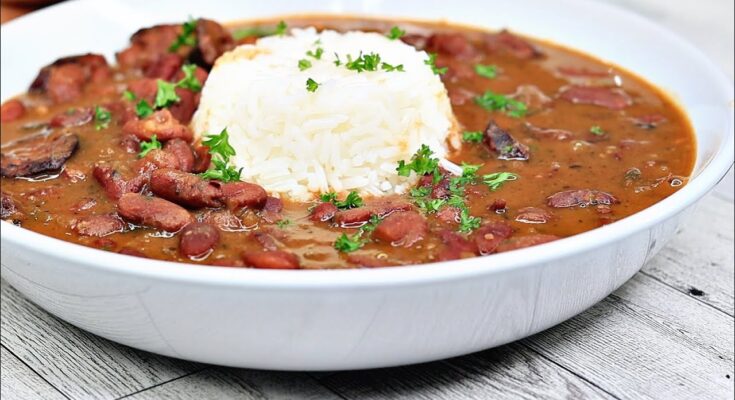Red Beans Recipe: Red beans have long held a cherished place in the culinary traditions of the American South, Caribbean islands, and various Latin cultures. Whether you’re enjoying a bowl on a lazy Sunday or meal prepping for the week ahead, red beans offer both comfort and nutrition. Packed with plant-based protein, fiber, and rich earthy flavor, red beans are the ultimate kitchen staple for home cooks who want flavor and function in one dish.
This guide will walk you through everything you need to make delicious red beans from scratch. From soaking to simmering, you’ll learn each essential step in a way that’s easy, digestible, and delicious. You’ll be surprised at how versatile and budget-friendly this hearty dish can be. Let’s dig in!
Ingredients Needed for Red Beans
To cook authentic and flavorful red beans, you’ll need a combination of pantry staples and a few fresh ingredients. Below is a list of what you should gather before you begin:
Main Ingredients:
- 1 pound of dried red beans (kidney beans work well)
- 1 large onion, chopped
- 1 bell pepper (any color), chopped
- 2 celery stalks, chopped
- 4 garlic cloves, minced
- 1 smoked sausage or ham hock (optional but adds rich flavor)
- 1 bay leaf
- 6 cups of water or low-sodium chicken broth
- Salt and black pepper to taste
Optional Ingredients for Extra Flavor:
- 1 tsp thyme (dried or fresh)
- ½ tsp cayenne pepper (for a spicy kick)
- 1 tsp paprika
- 2 tbsp tomato paste
- 1 tsp liquid smoke (for vegan version of smoky flavor)
- Green onions for garnish
- Fresh parsley for garnish
Substitutions and Adaptations:
- Vegetarian version: Omit meat and use vegetable broth
- Low sodium: Use unsalted broth and control salt manually
- Spicy lovers: Add a diced jalapeño or more cayenne
- No time for dried beans? Use canned beans but rinse thoroughly and reduce cook time.
Having everything ready and prepped makes the cooking process smoother and less stressful. Prep all your vegetables before starting the stove to keep the flow in the kitchen.
Tools and Equipment Required
You don’t need a fancy kitchen setup to make killer red beans, but having the right tools can certainly elevate the process.
Essential Tools:
- Large heavy-bottomed pot or Dutch oven
- Wooden spoon or spatula for stirring
- Measuring cups and spoons
- Chopping board and sharp knife
- Colander for rinsing beans
- Ladle for serving
Helpful Extras:
- Pressure cooker or Instant Pot (for quicker cooking)
- Slow cooker (for hands-free simmering)
- Bean masher (if you like your beans creamy)
Investing in a good-quality pot will ensure even heat distribution, which is crucial for simmering beans evenly. A non-stick bottom also helps prevent burning during the long cooking process.
Preparing the Red Beans
The first step in your red bean journey starts the night before—or at least a few hours in advance. Dried beans need to be soaked before cooking to improve their texture and digestibility.
Method 1: Overnight Soaking
- Rinse the beans thoroughly under cold water to remove dust or debris.
- Place beans in a large bowl and cover with 2-3 inches of water.
- Let them soak for at least 8 hours or overnight.
Method 2: Quick Soak (For Time-Savers)
- Rinse and add beans to a large pot.
- Cover with water and bring to a rapid boil.
- Boil for 5 minutes, then turn off heat and let sit for 1 hour.
- Drain and rinse again before cooking.
Soaking beans not only shortens cooking time but also helps remove some of the compounds that cause digestive issues. Always discard the soaking water and use fresh water or broth for cooking.
Step-by-Step Cooking Instructions
Here comes the heart of the recipe—turning those soaked beans into a soul-warming, rich, and flavorful pot of goodness.
Step 1: Sauté the Aromatics
Heat a splash of oil in your pot over medium heat. Add chopped onions, celery, and bell peppers—this trio is known as the “Holy Trinity” in Cajun cooking. Stir and cook until softened, about 5-7 minutes. Add garlic and cook for another minute until fragrant.
Step 2: Add Seasonings and Proteins
Stir in your seasonings: thyme, paprika, cayenne, salt, pepper, and tomato paste if using. Toss in your sliced sausage or ham hock. Let everything sauté together for another 2-3 minutes to deepen the flavor.
Step 3: Simmering the Beans
Pour in the soaked and drained red beans. Add enough water or broth to cover the beans by about 2 inches. Drop in your bay leaf. Bring the pot to a gentle boil, then reduce the heat to low. Cover and simmer for 1.5 to 2 hours, stirring occasionally.
Step 4: Adjusting Thickness and Flavor
As the beans cook, they’ll start to break down and thicken the broth naturally. If you prefer creamier beans, mash a small portion with a spoon or use a bean masher. Taste and adjust seasoning as needed.
Step 5: Final Touches and Resting
Remove the bay leaf and meat bones if any. Let the beans sit off heat for 10-15 minutes to allow flavors to settle. Garnish with chopped parsley or green onions.
Serving Suggestions
Red beans are incredibly versatile and pair well with a variety of sides and mains. The most iconic combination is Red Beans and Rice, a classic staple in Louisiana Creole cuisine. The hearty beans and savory sausage, paired with fluffy white rice, create a complete meal that’s both comforting and filling.
Here are a few serving ideas:
- Traditional Pairing: Serve red beans over a mound of steamed long-grain white rice. Garnish with green onions and a sprinkle of hot sauce for extra flavor.
- With Cornbread: A slice of warm, buttery cornbread adds a delightful contrast in texture and sweetness.
- Stuffed Baked Potatoes: Spoon hot red beans into a split baked potato, then top with cheese and sour cream.
- In a Bread Bowl: For a fun twist, serve your red beans in a crusty sourdough bowl.
- Tacos or Wraps: Use thickened beans as a filling for soft tortillas, topped with shredded lettuce, cheese, and avocado slices.
Whether you’re feeding a hungry family or looking to impress guests, red beans can adapt to any occasion. They’re rich, savory, and always satisfying.
Storage and Reheating Tips
One of the great things about red beans is how well they store. In fact, many say they taste even better the next day!
Refrigeration:
- Allow the beans to cool to room temperature before storing.
- Transfer to an airtight container.
- Store in the refrigerator for up to 5 days.
Freezing:
- Portion beans into freezer-safe containers or resealable bags.
- Label with the date and freeze for up to 3 months.
- Leave space for expansion if using containers.
Reheating:
- Reheat on the stove over medium-low heat, adding a splash of water or broth to loosen the consistency.
- Alternatively, microwave in a microwave-safe dish with a cover, stirring occasionally.
Avoid repeated freezing and thawing to preserve the beans’ texture and flavor. Portioning ahead of time helps with meal prep and convenience.
Common Mistakes to Avoid
Cooking red beans isn’t overly complicated, but a few common pitfalls can ruin the dish. Here’s what to watch out for:
1. Skipping the Soak: While not mandatory, skipping the soak can lead to longer cooking times and potentially tough beans. Soaking also helps reduce gas-causing compounds.
2. Underseasoning: Beans soak up flavor slowly. Be generous with seasonings and taste throughout the cooking process. A bland bean dish is a tragedy you can avoid!
3. Using the Wrong Beans: Red kidney beans and small red beans are not the same. Either can work, but they cook differently. Small red beans have a smoother texture, while kidney beans are firmer.
4. Adding Acid Too Early: Tomatoes or vinegar added too early can toughen the skins and prolong cooking. Wait until beans are nearly tender before adding acidic ingredients.
5. Not Stirring Enough: Occasional stirring prevents sticking and promotes even cooking. If you forget to stir, you may find burnt beans at the bottom.
Nutritional Information
Red beans are more than just tasty—they’re a nutritional powerhouse. Whether you’re watching your health or bulking up your meals, red beans deliver.
| Nutrient | Per 1 cup cooked (without meat) |
|---|---|
| Calories | ~225 |
| Protein | 15g |
| Fiber | 13g |
| Carbs | 40g |
| Fat | 0.9g |
| Iron | 3.9mg (22% DV) |
| Potassium | 600mg+ |
Health Benefits:
- Heart Health: High fiber content helps lower cholesterol.
- Digestive Health: Promotes regularity and supports gut health.
- Blood Sugar Control: Low glycemic index keeps glucose levels steady.
- Muscle Repair: Plant-based protein supports muscle maintenance.
Adding red beans to your diet is a smart choice nutritionally, and they’re also gluten-free, dairy-free, and vegan when prepared without animal products.
Variations of the Red Beans Recipe
Love red beans but want to shake things up? Here are some regional and dietary variations that bring their own flair:
Louisiana-Style Red Beans: Includes smoked andouille sausage, more heat (think cayenne and hot sauce), and is typically served on Mondays with rice—a tradition dating back to laundry day meals.
Caribbean Red Beans: Uses coconut milk for a creamy base, with thyme, scallions, and sometimes allspice. Often paired with rice and peas.
Vegan Red Beans: Skip the meat, but don’t skip the flavor! Use mushrooms, liquid smoke, and vegetable broth for a deep umami taste.
Tex-Mex Red Beans: Add chili powder, cumin, and fire-roasted tomatoes. Serve with tortilla chips, guacamole, and cheese.
Indian-Style Rajma: This North Indian dish uses kidney beans with onion, tomato, ginger, garlic, and garam masala. Serve over basmati rice for a hearty vegan meal.
Red beans are a canvas—you can mix and match spices, herbs, and proteins to fit your taste and culture.
Tips for Perfect Red Beans Every Time
Even if you’ve followed the recipe to the letter, a few insider tips can elevate your red beans from good to unforgettable. Here’s how to perfect your pot every time you make it:
1. Cook Low and Slow: Beans need time to absorb flavors and soften to the perfect creamy texture. A slow simmer allows the ingredients to meld, enhancing the taste without breaking the beans apart.
2. Mash for Creaminess: Want that signature thick, hearty consistency? Take a ladle of beans out and mash them with a fork, then stir them back into the pot. It instantly transforms the broth into a silky, rich sauce.
3. Season in Layers: Don’t just dump all your spices in at once. Start with some early, then add more midway through and a final taste test at the end. This layering builds depth and prevents overpowering any one flavor.
4. Use Stock Instead of Water: If you have access to good-quality chicken or vegetable stock, use it! It adds a savory backbone that water simply can’t compete with.
5. Fresh Herbs Matter: A sprinkle of fresh parsley or green onion at the end can brighten the whole dish and bring freshness to every bite.
6. Let It Rest: Once you’ve turned off the heat, let your red beans sit for at least 10-15 minutes before serving. This helps the flavors settle and makes your beans even better.
7. Taste, Taste, Taste: Your tongue is your best tool. Check for salt, spice, and richness. If it tastes flat, try a splash of vinegar or a pinch of sugar—sometimes that little boost is all it needs.
Making red beans might be easy, but mastering them takes attention to detail. Trust your senses and don’t rush the process.
FAQs about Red Beans Recipe
1. What are the best beans to use for a red beans recipe?
Red kidney beans are the most commonly used beans for red beans recipes. They hold their shape well during cooking and absorb flavors beautifully.
2. Can I use canned beans instead of dried red beans?
Yes, you can use canned beans to save time. Just rinse them thoroughly before cooking to remove excess sodium and preservatives.
3. How long does it take to cook red beans from scratch?
If using dried beans, cooking time ranges from 1.5 to 2 hours after soaking. A pressure cooker or Instant Pot can reduce the time significantly.
4. Do I need to soak the red beans overnight?
Soaking overnight softens the beans and reduces cooking time. If you’re short on time, a quick soak (boiling for 5 minutes and resting for 1 hour) also works.
5. What can I serve with red beans?
Red beans are often served with white rice, cornbread, or fried plantains. They also pair well with grilled meats or sausages.
6. How do I store leftovers?
Allow the beans to cool completely before storing in an airtight container. Refrigerate for up to 4 days or freeze for up to 3 months.
7. Can I make red beans vegetarian or vegan?
Absolutely! Just skip the meat and use vegetable broth. Add extra spices or smoked paprika for a deeper flavor.
8. Why are my red beans still hard after cooking?
Old beans or acidic ingredients (like tomatoes) added too early can prevent softening. Always check the age of your beans and add acidic ingredients later in the cooking process.
Conclusion
Making red beans from scratch might sound like a labor of love—and it is—but it’s also incredibly rewarding. From that first sizzle of aromatics hitting the pan to the last spoonful of creamy, flavorful beans, each step brings you closer to a dish that’s equal parts comfort and nutrition.
Whether you’re going traditional with sausage and rice or trying out a vegan Caribbean twist, red beans offer a world of flavor and endless versatility. Follow this guide, trust your taste buds, and don’t be afraid to put your own spin on it. Once you’ve made them once, they’ll become a regular feature in your home-cooking rotation.
Here’s to hearty meals and happy bellies!



